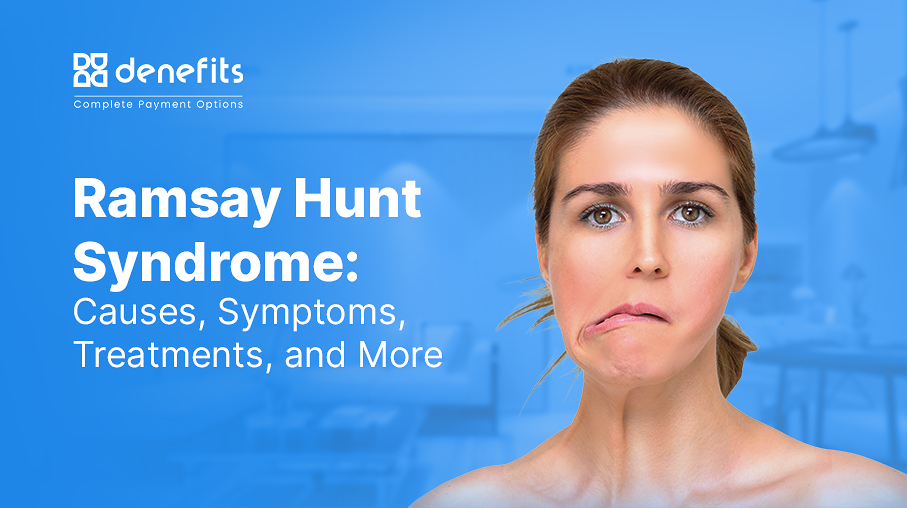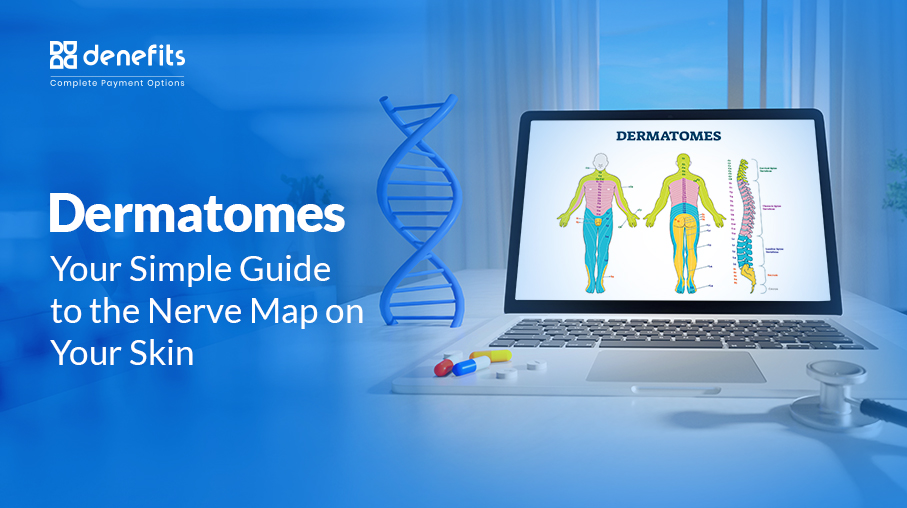
Quick Answer
Ramsay Hunt Syndrome develops when the varicella-zoster virus reactivates and infects the facial nerve near the ear. This can lead to facial paralysis and a painful rash. In some cases, it may also cause hearing problems or dizziness.
An ear rash, facial paralysis, and hearing loss aren’t just random symptoms—they’re classic signs of Ramsay Hunt Syndrome. Clinically, it’s also called herpes zoster oticus or Ramsay Hunt Syndrome type 2. It gained public attention after affecting several well-known celebrities. But what exactly is it, and why does it happen?
We’ve got all the details in our blog.
It’s estimated that Ramsay Hunt Syndrome impacts 5 individuals out of every 100,000 in the U.S. each year. Interestingly, it impacts both men and women equally.
What is Ramsay Hunt Syndrome?
Ramsay Hunt Syndrome is a rare illness caused by a virus that can stay in your body after having chickenpox. For some people, this virus wakes up again later and attacks the nerves in the face. This can lead to sudden facial drooping, a painful rash, and sometimes dizziness or hearing loss. Other signs include facial paralysis and blisters near the ear or mouth.
The syndrome is named after Dr. James Ramsay Hunt, who was the first to link shingles with facial nerve damage in the early 1900s.
His observations showed that shingles could lead to both a painful rash and weakness or paralysis in the face. For that reason, he connected the condition to the varicella-zoster virus affecting the geniculate ganglion. It is a key nerve center linked to facial movement. Since then, this rare syndrome has carried his name and continues to be studied for its complex symptoms and effects.
Ramsay Hunt Syndrome Causes
Ramsay Hunt Syndrome happens when a virus that causes chickenpox and shingles comes back to life in the body. Even after a person recovers from chickenpox, the virus can stay hidden in the nerves and reactivate years later. When it does, it may cause sudden facial weakness, blisters, ear pain, and sometimes dizziness or hearing loss. If not treated, it can lead to facial paralysis and a rash near the ear.

Know Your Body Better, One Nerve at a Time!
Don’t miss this easy guide to exploring your skin’s nerve map with dermatomes.
Effect of Ramsay Hunt Syndrome
1. Facial Paralysis on One Side
One of the most prominent effects is weakness or complete paralysis of the muscles on one side of the face. Since the virus targets the facial nerve, everyday actions like smiling, closing the eye, or talking can become difficult.
2. A Painful Rash
You may see a painful, blistering rash forming near the ear, on the head, or even inside the mouth. This rash is typically accompanied by severe pain and is a key identifying symptom.
3. Hearing Problems
Hearing may be reduced in the impacted ear, with some people also noticing ongoing sounds like ringing or buzzing. It can be both irritating and disruptive.
4. Dizziness or Vertigo
Since the inner ear and balance nerves can be involved, many patients feel unsteady, dizzy, or experience vertigo.
5. Altered Sense of Taste
Due to the involvement of taste-related nerve fibers, taste perceptions may be reduced or changed. It may happen particularly on the front two-thirds of the tongue.
6. Dryness of Eyes or Mouth
Damage to facial nerves can affect the tear and saliva glands, leading to dry eyes or a dry mouth. This not only causes discomfort but can also increase the risk of infections or eye injuries.
How Ramsay Hunt Syndrome Type 2 Is Different From Type 1?
Type 1 Ramsay Hunt Syndrome affects the part of the brain that controls balance and movement (the cerebellum). It may be linked to the immune system attacking the body or certain types of cancer. On the other hand, Type 2 is more well-known and happens when the virus that causes chickenpox becomes active again. This type affects the facial nerve near the ear and can cause a painful rash, weakness on one side of the face, hearing problems, ringing in the ear, dizziness, and trouble closing one eye.
Ramsay Hunt Syndrome vs Bell’s Palsy
| Feature | Ramsay Hunt Syndrome | Bell’s Palsy |
| Cause | Reactivation of varicella-zoster virus (shingles) | Often linked to the herpes simplex virus, the exact cause is unclear |
| Facial Paralysis | Yes – usually on one side | Yes – typically on one side |
| Rash | Painful rash near the ear, face, or mouth | No rash |
| Ear & Hearing Issues | May include tinnitus, hearing loss, ear pain | Rarely causes ear-related symptoms |
| Balance Problems | Vertigo or dizziness may occur | Uncommon |
| Pain Severity | Usually more painful | Typically mild or no pain |
| Recovery | It may take longer, with the risk of incomplete recovery | Often faster, with full recovery in most cases |
| Treatment | Antivirals + corticosteroids | Usually just corticosteroids |
| Contagious | Not contagious, but a virus can spread | Not contagious |
Is Ramsay Hunt Syndrome Contagious?
This syndrome is a complication of the varicella-zoster virus, which remains silent after a person has had chickenpox. Therefore, it is not contagious as the virus stays in the person’s body itself.
However, it’s possible to transmit the virus to someone who’s never had chickenpox or received the vaccine. In such cases, if exposed, they may develop chickenpox instead of Ramsay Hunt Syndrome. While the syndrome isn’t directly transmissible, precautions should still be taken. It is especially suggested for individuals with weakened immune systems, pregnant women, or newborns.
Who Is Most at Risk
The risk of developing Ramsay Hunt Syndrome increases with certain factors. Primarily, it affects individuals who have previously had chickenpox. It is because the varicella-zoster virus remains dormant in the body and can reactivate later. Those with compromised immunity, including individuals undergoing cancer treatment, managing HIV, or taking immune-suppressing drugs, are more likely to develop the syndrome.
It also occurs more frequently in seniors, particularly those above the age of 60. Although rare in children, it can still occur. Therefore, a combination of past viral exposure, age, and immune system status significantly influences the risk of developing Ramsay Hunt Syndrome.
Ramsay Hunt Syndrome Treatment
For those with Ramsay Hunt Syndrome, different treatments are available to improve facial function and appearance. These can help with better smile control, smoother facial movements, and less tightness or stiffness.
Surgeries
1. Selective Denervation
If facial muscles become tight or move abnormally after Ramsay Hunt Syndrome, selective denervation can offer relief. This treatment involves removing or cutting tiny nerve branches that are sending the wrong signals to the face. This often leads to better control while smiling and a noticeable decrease in involuntary muscle movements. Still, it’s only used when simpler treatments don’t give good results.
2. DAO excision
It is a minor surgical procedure used to help improve facial balance, especially in people with facial drooping. The DAO (depressor anguli oris) is a small muscle that pulls the corner of the mouth downward. By targeting this muscle, surgeons can elevate the sides of the mouth, resulting in a more even-looking face. As a result, patients often see a more balanced smile. However, this option is usually considered when other non-surgical treatments haven’t worked.
3. Depressor labii inferioris (DLI) excision
DLI excision is a small surgery used to improve facial balance. It is especially done when one side of the lower lip pulls down more than the other. The depressor labii inferioris is the muscle responsible for pulling the lower lip downward. By removing or weakening this muscle, doctors create a more even appearance when speaking or smiling. Therefore, the lips look more balanced and natural.
4. Facelift for Facial Paralysis
A facelift is another helpful option, especially as facial drooping can become more noticeable over time. By lifting the paralyzed side, the face looks more balanced. Surgery is usually done under general anesthesia. Sometimes with local anesthesia and light sedation. Additionally, it’s often paired with other facial procedures to improve both appearance and function.
Medications
1. Antiviral Medicines (Like Acyclovir or Valacyclovir)
Help fight the virus causing the condition. Works best if taken early. These antivirals work best when started within 72 hours of symptom onset. They help control the virus, potentially reducing the severity and duration of symptoms like facial paralysis, rash, and nerve pain.
2. Steroids (Like Prednisone)
To reduce inflammation and swelling around the facial nerve. Steroids improve the likelihood of nerve recovery and reduce the risk of permanent facial weakness. When combined with antivirals, they’re considered the most effective standard treatment.
3. Pain Relievers
They manage nerve pain and ear discomfort. Pain can be intense due to nerve involvement. These medications provide symptomatic relief, improving comfort and sleep.
Common Medications:
- Tramadol
- Acetaminophen (Tylenol)
- Ibuprofen (Advil, Motrin)
4. Anti-Anxiety or Anti-Dizziness Medicines (If Needed)
These medications help patients manage prolonged nerve-related pain (postherpetic neuralgia).
Common Medications:
- Gabapentin (Neurontin)
- Pregabalin (Lyrica)
- Amitriptyline (a tricyclic antidepressant)
These help calm overactive nerve signals and are used when pain persists beyond the initial phase.

Ramsay Hunt Syndrome Recovery Time
The recovery time for this syndrome can vary significantly depending on when treatment begins and the severity of symptoms. Typically, if antiviral and steroid medications are started within 72 hours of symptom onset, the chances of full recovery are much higher. However, some individuals may take several weeks to a few months to regain full facial movement. In some cases, especially when treatment is delayed or the nerve damage is severe, recovery may be partial. It can lead to long-term complications like facial weakness, muscle twitching, or hearing loss. Therefore, early diagnosis and immediate medical attention play a crucial role in improving outcomes.
Complications That May Arise If Left Untreated
➮ Hearing Loss or Tinnitus
If the virus affects the auditory nerve, it can result in partial or complete hearing loss in the affected ear. This damage may be temporary or permanent, depending on the severity and timing of treatment. Many individuals also report persistent tinnitus. It is a constant ringing, buzzing, or hissing sound that can interfere with concentration, sleep, and overall quality of life.
➮ Eye Complications
Facial paralysis can affect the muscles that help you blink or close your eyes. When the eye doesn’t close all the way, it can become dry, irritated, or red. Furthermore, if the eye isn’t kept moist and protected, people use eye drops, ointments, or an eye patch. As a result, it could lead to scratches on the eye, infections, and in serious cases, even vision loss.
➮ Postherpetic Neuralgia
Even after the rash and facial weakness get better, some people still feel long-lasting pain in the same area. This is called postherpetic neuralgia, and it happens because the virus damaged the nerves. The pain may feel like burning, stabbing, or throbbing, and it can last for months or even years. This can make it hard to feel comfortable or go about daily life.
➮ Spread of the Virus to Other Nerves
Although uncommon, if left unchecked, the varicella-zoster virus can extend beyond the facial nerve and affect other cranial or peripheral nerves. This could lead to dizziness, balance issues, speech problems, or even difficulty swallowing, depending on the nerves involved. In very rare cases, it could also lead to meningitis or encephalitis, which are serious neurological conditions.
➮ Psychological Impact
Living with facial weakness or improper facial movement, or ongoing pain, can drain people emotionally. Many people feel worried, sad, or avoid social situations. Especially in situations when recovery takes time. Changes in appearance can affect confidence, make it harder to connect with others, and reduce overall happiness and quality of life.
If left untreated, this syndrome can impact a person's life in multiple ways. The complications can be serious, but so can the cost of proper care. So, how much does it all add up to? Here’s a closer look at the financial side of treatment.
How Much Does Treatment Really Cost?
That’s a very real concern. And one that many patients in the U.S. face, especially those diagnosed with Ramsay Hunt Syndrome. While the condition is treatable, it often comes with a heavy price tag. Surgical procedures can range anywhere from $7,000 to $50,000, depending on the type and complexity of the surgery. On top of that, the ongoing cost of medications and follow-up care can add up quickly over time.
So, is there a way to make it all more affordable?
Fortunately, yes! There are financing solutions that can ease the financial burden without delaying your care.
Denefits—Flexible Payment Plans That Fit Every Budget
A lot of healthcare providers now offer Denefits payment plans to help you cover treatment costs without the financial stress. Rather than worrying about a large, one-time payment, you can spread the cost over manageable monthly payments. What sets Denefits apart is that you don’t need a strong credit score to get started. Also, approval is accessible to many. As a result, you receive timely care, not limited by your current financial situation.

FAQs
1. What Is Ramsay Hunt Syndrome?
Ramsay Hunt Syndrome is a neurological condition caused by the reactivation of the varicella-zoster virus (that causes chickenpox and shingles). It leads to facial paralysis on one side and a painful rash around the ear or mouth.
2. What Is the Cause of Ramsay Hunt Syndrome?
Ramsay Hunt Syndrome is caused by the reactivation of the varicella-zoster virus, which stays dormant in the body after a person has had chickenpox.
3. Can You Fully Recover From Ramsay Hunt Syndrome?
Yes, many people can fully recover from Ramsay Hunt Syndrome, especially if treatment starts within 72 hours of symptom onset.
4. Can Stress Cause Ramsay Hunt Syndrome?
Stress doesn’t directly cause Ramsay Hunt Syndrome, but it can weaken the immune system, making it easier for the varicella-zoster virus to reactivate.
5. What Is the Classical Ramsay Hunt Syndrome Triad?
The Ramsay Hunt Syndrome triad includes facial paralysis, ear pain, and a blistering rash in or around the ear or mouth.




